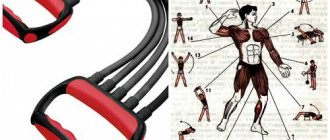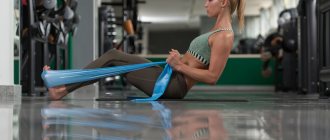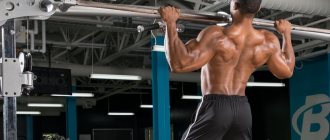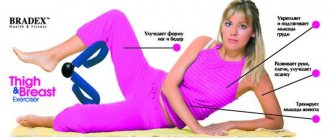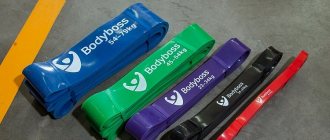What to do if you want to train not only in the gym, but also at home or on vacation? An expander will help us with this. This is a universal invention that allows you to work out all the muscle groups of our body. Unlike barbells and dumbbells, a rubber expander does not take up much space, and it itself is lightweight. But how then do we get results from it? The principle is simple, expanders come in different hardnesses. Therefore, it is worth choosing them correctly. For example, dark orange and black expanders are suitable only for experienced athletes for strength work. Beginners are better off choosing something in between. Starting from yellow to blue. Its resistance force depends on how rigid the expander is. Which we will confront during training with him. Don't worry, we won't calculate hardness using special formulas. As in working with hardware, we will rely on our own feelings. Trying to technically correctly perform a given number of times and approaches.
Exercises with an expander
We will look at the most popular exercises with an expander. To do this, we will divide the body into main muscle groups: chest, back, shoulders, biceps, triceps, legs, abs. To perform some exercises, you will need to secure the expander to something at the top or bottom. And if there are no problems with this in the gym, then they can arise at home. Some people attach the expander to pipes, batteries, or press it against a door. But all this is not very safe, and can lead to various unpleasant situations. Therefore, it is better to purchase a special bracket and screw it into the ceiling.
For babies
Bench press with expander
This exercise is very familiar to any person. Basically, everyone is used to performing it with a BARBERL or DUMBBELLS. But in our case, we will use a rubber expander. This exercise will help work the pectoralis major muscles.
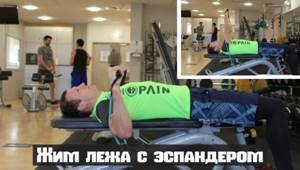
Performance:
- Lie down on a bench press or place your upper torso on a chair and place your feet on the floor.
- Slide the resistance band under the bench and grab its edges.
- Unlike working with dumbbells, we will start the exercise from the bottom point.
- Exhale and push your arms up. There is no need to bring them together.
- We take a short break, giving the breasts the opportunity to work statically.
- And while inhaling, bend them at the elbow joints, returning them to their original position.
Watch your technique. At the top point, be sure to pause, giving the chest the opportunity to compete with the force of compression. Unlike classic bench presses. The expander makes it possible to maximally load the pecs at the top point. Some use it in conjunction with a barbell, attaching it to its edges. This gives you a double advantage.
Lying arm raises with an expander
Another exercise that should be in your arsenal. It is analogous to ARM FLIES WITH DUMBBELLS, and helps to work out the pectoralis major and minor. It also stretches muscle fibers. Making our pecs visually even larger.
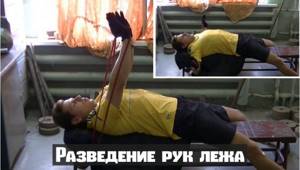
Performance:
- The principle of execution here is almost the same as in the previous exercise.
- We lie down on a bench or chair.
- We push the expander under them and take hold of its edges.
- We bring our hands together.
- As you inhale, we begin to move them in different directions, stretching the pectoral muscles as much as possible.
- At the lowest point, take a short pause.
- Then, while inhaling, we begin to move the edges of the expander towards each other, until they are completely brought together at the top point.
It is very important that your movements are controlled. Don't relax when breeding. If you find it difficult to perform the exercise, take a less rigid resistance band. And most importantly, do not turn the fly into a bench press. At the top point, the arms should be slightly bent at the elbow joints.
Resistance push-ups
This is the most accessible basic exercise. To perform it, we only need an expander and a surface against which we will rest. Performing PUSH-UPS WITH WIDE HANDS will allow us to shift the load on the pectoral muscles. The expander in this exercise will act as an additional weight. If we want to modify the exercise a little, then we can put our feet on a hill. This will shift the load from the middle of the pecs to their upper part.

Performance:
- Take the expander by the two ends in your hands. Throw it behind your back.
- Take a lying position, pressing the ends of the expander with your palms to the floor.
- As you inhale, bend your arms at the elbow joint and lower your body down almost until your chest touches the floor.
- Stay in this position for 1-2 seconds.
- Then, as you exhale, straighten your arms and push yourself off the floor.
When lowering, do not relax your arms, especially when working with stiffer resistance bands. While moving, keep your body straight. Do not lower or lift your pelvis. Try to feel the work of your pectorals in each phase of the exercise.
How to choose an expander
Even such simple exercise machines can be of different types and different levels of rigidity. The following types of hand expanders can be distinguished:
- The rubber “donut”, which fits well in the palm of your hand and is as easy as possible to use, however, has constant rigidity (it cannot be adjusted and, as a rule, it is no more than 25 kg) and is not always convenient in training, and can cause discomfort when squeezing.
- “Butterfly” is a hand trainer that resembles pliers, which has a spring instead of a metal part. It is these plastic handles, connected by a spring, that are compressed during training. Can be equipped with a stiffness adjustment mechanism. It is the most versatile, as it is suitable for both beginners and more professional athletes.
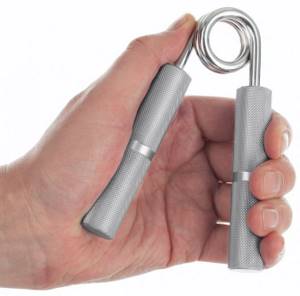
The steel expander is a tool for professionals. It can be called an expander for men, since such a steel exercise machine can have a rigidity of up to 160 kg. It is better not to use such an expander for beginners.
Whatever type is preferred, it is very important to choose the right stiffness, otherwise the training will not bring either internal satisfaction or the expected result. The right hand trainer should allow you to do about 50 squeezes in about 1-1.5 minutes, but without breaks. If the hand refuses to work earlier, then a less rigid expander is needed. If more than 100 compressions in a row are easily done, then it’s time to increase the load, that is, increase the rigidity.
For the back
Bent over expander row
Let's start with basic exercises aimed at developing back thickness. It is an analogue of the BAR ROLL IN THE INCLINE. Depending on the angle of inclination, we can shift the load from the top to the bottom of the latissimus muscles. Due to the fact that we perform rows with both hands, we can take more rigid expanders. This will increase the load on the working muscles. As a result, they will begin to grow.
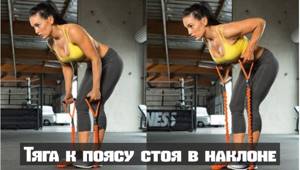
Performance:
- Stand with both feet in the middle of the expander and take its edges in your hands.
- We move the pelvis back and tilt the body forward. For greater stability, bend your knees slightly.
- The back should be straight, there should be a slight arch in the lower back, and the gaze should be directed forward.
- As you exhale, we begin to bring the shoulder blades together and pull the edges of the expander to the lower abdomen (the area under the navel).
- Hold this position for a short time to maximize the load on the latissimus and rhomboid back muscles.
- Then, as you exhale, we return to the starting position.
Perform deadlifts by contracting your back muscles rather than bending your arm. To do this, focus on squeezing your shoulder blades together and lifting your elbows up. Take your time, do the exercise at an average pace. If you have done this deadlift before, only with a barbell. Then at first, performing it with an expander will not be familiar. But this is a temporary effect and it will pass quickly.
Vertical thrust
And again, a basic exercise for training your back. Basically, VERTICAL PULLING is performed in a crossover. It is aimed at increasing the width of the back. To complete it, we will need to secure the expander to something. I have already written about this earlier. We can also work on different areas of the back and increase the range of motion. This is achieved by positioning the edges of the expander relative to each other. The closer they are, the greater the amplitude will become and the load will fall on the bottom of the lats. A wide stance uses the upper part of the lats. But this will reduce the amplitude.

Performance:
- Secure the middle part of the expander to the bracket installed at the top. Or press it against the door (assuming your doors are secure).
- Grab its edges with your hands and kneel down.
- As you exhale, pull the edges of the expander down.
- As you inhale, return to the starting position.
Beginners will find it difficult to feel the work of their back at first. But there is a proven method. You need to focus on lowering your elbows rather than bending your arm at the elbow joint. And then the biceps will not dominate the exercise.
Horizontal thrust
Another exercise option for the back that helps develop its thickness. It is performed while sitting on the floor. It is analogous to the LOWER BLOCK ROD. As in the vertical row, we also increase the amplitude of movement by bringing the edges of the expander together. A kind of close grip deadlift.
Benefits and harms from use
First of all, you should find out what the benefits and harms of a hand expander are. It is noted that when choosing a high-quality simulator and following the rules for its use, only a positive effect is observed. Here are the muscles the product pumps: the hands, wrists, the front of the forearm area, as well as the finger flexors. Excessive loads and the use of dubiously manufactured products lead to negative changes.
The benefits of a hand expander for the body are as follows:
- Preventing the development of arthritis and arthrosis. During training, the load on the joints is measured, but they actively work, and accordingly, the risk of the onset of pathological processes is significantly reduced.
- Stimulation of blood circulation. When using an expander, the hands perform movements similar to those that need to be done when drawing blood from a vein. Accordingly, during exercise, the vessels begin to work actively, the blood pumps more intensely, at an increased speed. Thanks to such changes, beneficial substances spread faster throughout the body, improving the condition of the skin and nail plates.
- Preventing sprains and injuries during weight training. With sufficient strength in the hand area, a person correctly distributes the load and applies it to the necessary muscle tissues.
- Training normalizes the activity of the nervous system. Models with pimples have an effect on a number of nerve endings and help eliminate overstrain.
- Restoring motor skills after injuries. For example, when a fracture occurs, the arm remains motionless for a long time, as a result of which the muscles begin to atrophy, blood circulation is disrupted, and the affected tissues do not receive the proper amount of oxygen. To normalize the condition, you need an expander. Soon all problems when using it disappear.
If you train regularly, the compact device will be of great benefit. True, there is a downside. In certain situations, exercise can cause harm. For example, if exercises are performed incorrectly, there is a risk of injury. If the load is excessive, pain appears in the joints and muscles.

Prevents the development of arthritis and arthrosis

Stimulates blood circulation

Helps restore motor skills after injuries
For triceps
Extension of arms from behind the head
This exercise will help develop all three heads of the triceps with a slight emphasis on the long head. It can be performed with one hand or with both at the same time. In the world of bodybuilding, these EXTENSIONS are DONE WITH A DUMBBELL.
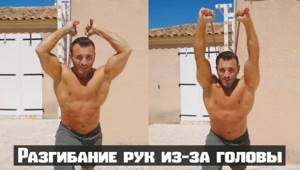
Performance:
- Stand in a separate line. That is, one leg is in front and the other is behind.
- Attach an expander to your back foot.
- Take its edges in your hands and lift them above your head.
- As you inhale, bend your arms at the elbow joints and lower the edges of the expander behind your head.
- Take a short break and stretch your triceps as much as possible.
- As you exhale, straighten your arms and return to the starting position.
Watch the position of your elbows; they should not diverge too much to the sides. Keep them as close to each other as possible. Work exclusively by contracting the triceps. Don't help yourself with your feet.
Bent press with expander
I think many people are familiar with this exercise. This is a modified version of the CROSSOVER DOWN PRESS. Allows you to work your triceps in isolation. Most of the load will fall on its lower part. And by turning the hand from a neutral position to a pronated one, we can shorten the long head as much as possible. You can perform the exercise with one hand or two at the same time. Also, it is possible to use a variety of grips: neutral, pronated (palms down) and supinated (palms up).
For biceps
Arm curls with an expander
I think everyone knows that the most common exercise for biceps is the BELL BAR CURL. So we will do something similar only with an expander. There is an opinion that a change in the position of the hands relative to each other. May change the tension on each biceps head. A narrow arrangement puts more stress on the long head, and a wide one on the short one. But you won't feel much of a difference. Therefore, this moment can be used to diversify the exercise.
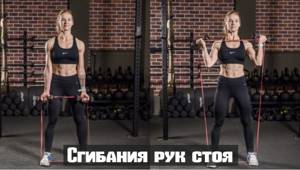
Performance:
- Stand on the middle of the expander with your feet.
- Take its ends in your hands.
- Lean forward slightly and bend your knees. This will make your position more stable.
- Press your elbows close to your body.
- As you exhale, bend your arms by contracting your biceps.
- We take a short pause in the upper position and slowly straighten our arms.
Do not lift your elbows up when bending your arms. Perform the exercise only by contracting your biceps. Don't swing or use your leg muscles.
Reverse grip curls
To fully develop the arm muscles, you need to train another muscle. We are talking about brachialis. It is located under the biceps and is responsible for the same function, bending the arm at the elbow. A reverse grip (pronated) allows us to exclude the biceps muscle from the exercise, so we can load the brachialis more heavily.
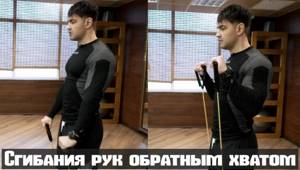
Performance:
- To perform reverse curls, it is best to use an expander with handles.
- The starting position is the same as in the previous version.
- We stand in the middle of the expander and take its edges in our hands with a pronated grip.
- As you exhale, bend your arms at the elbow.
- We take a short pause, and while inhaling, we straighten them.
Do not bend your arms while doing this. Watch the position of your elbows. They should not extend forward or backward relative to the body.
Types of hand expanders
There are hard and soft expanders. They are also classified according to the material of manufacture, diameter, thickness, massage coating and shape. There are three main types of simulator:
- Rubber. It has a maximum hardness of 25 kg, so it is recommended for beginners. The most affordable option is from 100 rubles. Shape: ring, ball. Butterfly (sometimes called scissors). This is a spring simulator that looks similar to pliers or tongs. It has two metal or plastic handles that are connected by a spring. There are two types: regular and adjustable in rigidity. It is more convenient to use compared to rubber, but its cost is higher - from 180 rubles. Minimum hardness – 20 kg.
- Steel. Used by professional athletes. The rigidity can reach 160 kg. Captains of Crush is very popular - it is considered the standard in quality, assembly and design. You can purchase such a “unit” only in specialized sporting goods stores. The simplest steel model costs from 600 rubles.
- Gyroscopic. This is a new product, better known as Powerball. A unique “device”, the work with which is based not on squeezing, but on holding the hand in a certain position or rotational movements. The average cost of a basic model is from 500 rubles.

To the listed types you can also add gel expanders, which appeared relatively recently on the sporting goods market. But they are not suitable for strength training. Pleasant to the touch, have an anti-stress effect. Suitable for older people, children and girls. Sold in sets of several pieces and individual units.

The quality of the simulator largely depends on the manufacturer. The brands Torneo and IronMind (the latter produces the legendary Captains of Crush expander) have proven themselves well in the modern market.
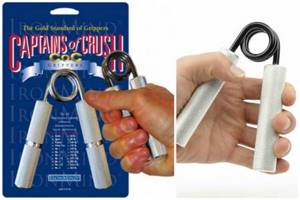
For legs
Squats with an expander
When it comes to leg training, the first thing that comes to mind is SQUATS. This is a great exercise to target your quadriceps and glutes.
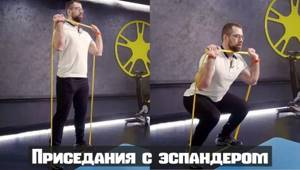
Performance:
- The beginning is standard for exercises performed while standing.
- We stand in the middle of the expander. We place our legs hip-width apart (slightly narrower than shoulder width).
- We take the edges. We bend our elbows and place them in front of us, so that the expander is behind our forearms.
- The back is straight, there is a natural arch in the lower back. The gaze is directed forward and slightly upward.
- As you inhale, move your pelvis back and bend your knees.
- We take a short pause in the lower position.
- And as you exhale, we rise from the squat.
Watch the position of your knees. In the lower position they should not protrude beyond the toes. While squatting, do not look at your feet. This will make you round up. Start squats with abduction of the pelvis, not bending at the knee.
Become traction on straight legs
Well, where would we be without STANDING ON STRAIGHT LEGS. This exercise helps develop the muscles in the back of the thigh. Which receive virtually no load when doing squats.
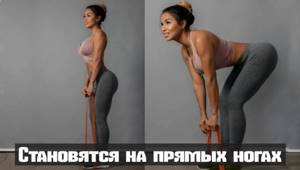
Performance:
- We stand in the middle of the expander and take its ends in our hands.
- As you inhale, we begin to move the pelvis as far back as possible, due to which the forward tilt will occur.
- Stretching the muscles of the back of the thigh as much as possible. Exhale and return to the starting position.
While bending over, do not bend your knees. This will shift the load from the thigh muscles to the gluteal muscles. Do not round your back to avoid damaging your spine.
Lunges with expander
This is a basic exercise that allows you to load the gluteal muscles and quadriceps. LUNCHES can be performed in different ways. Taking a step forward and back. This will load the muscles differently. We will consider the technique of only the classic version.
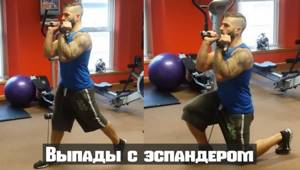
Performance:
- We stand with one foot in the middle of the expander, and move the other one back.
- We take the edges with our hands and bend them at the elbow.
- While inhaling, bend the leg at the knee joint until an angle of 90° is formed in it.
- After taking a short pause and exhaling, straighten your leg by contracting the quadriceps and gluteal muscles.
While performing the exercise, do not lean forward too much. Make sure that your knee does not extend beyond your toes.


